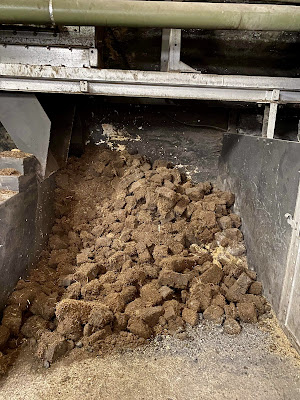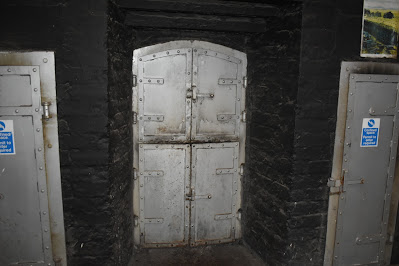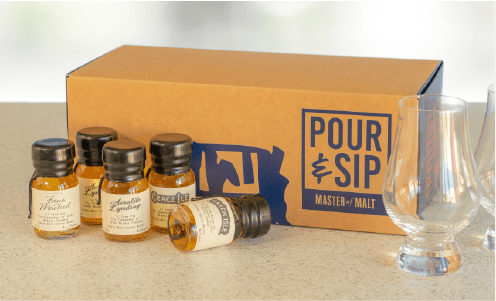Distillery visit and Warehouse 1 tasting - Laphroaig August 2022
For me, no trip to Islay would be complete without a visit to Laphroaig. The 10 year-old was my first introduction to single malts many years ago and has been a constant in my whisky cabinet ever since. This time round we decided to treat ourselves to the Distillers Wares tour and tasting session in the legendary Warehouse One.
Founded in 1815 by farming brothers Donald and Alexander Johnston, Laphroaig (pronounced La-froyg), is named after its location, ‘broad hollow by the bay’ and sits on the south coast of the island.
 |
| Barley delivery day |
Laphroaig is one of a few distilleries on Islay that still have their own maltings, although the volume produced only makes up a proportion of their overall requirements.
What may seem like a simple process of allowing the grain to germinate is actually more complex and labour intensive than first appears. The germinating malt needs aeration so the malt has to be manually turned several times a day. Temperature and humidity are also vital factors, with the thickness of the bed being kept deeper during the cooler months.
 |
| One of the malting floors |
Once the required level of fermentable sugar has been reached in the germinating grain the process needs to be stopped. At this point it is moved to the peat kiln which acts by slowly drying out the grain in addition to introducing the characteristic Islay peat smoke.
Due to its location and geography, Islay has historically had limited woodland which means the peat bogs differ in their composition to those of mainland Scotland, and it is this difference which gives Islay peated whiskies their distinctive characteristics.
There are also regional differences depending on the location of the peat bog on the island. Laphroaig’s own Glenmachrie peat bog contains a mix of heather, lichen and moss which, when burned, brings with it the signature medicinal profile.
 |
| Peat, glorious peat |
The peat kilns at Laphroaig were built in 1840, only 25 years after the distillery was founded.
They weren’t using the kiln on the day we went, but this just gives me an excuse to post a photo from our first visit many years ago..and yes, I was grinning from ear to ear for getting the chance to do this!
The peating process at Laphroaig differs from the majority of Scottish distilleries in that it is carried out whilst the malted barley is still damp. The process takes around 17 hours, with the smoke from the fire rising up through a perforated drying floor where the damp barley sits. This is the point where the barley takes on the characteristic aromas and flavours of the peat smoke. By burning the peat at a relatively low temperature, a tarry 'cold smoke' is produced which adds to the typical Laphroaig character.
 |
| The drying floor |
The smoke is drawn through from the oven and up through the floor, filling the room before finally dispersing through the cupola, the characteristic pagoda-style chimney commonly found on distilleries, including many who no longer malt their own barley.
 |
| Inside the cupola |
Once the process is complete, the peated barley is dried using hot air ready for milling before transfer to the Mash House.
 |
| The Porteus Mill |
 |
| Mash tun |
After the extraction stage using water at increasing temperatures, the resultant wort is transferred to one of the six 53,000 litre stainless steel wash backs.
 |
| One of the six wash backs. |
Following a fermentation period of a minimum of 55 hours, the yeast has converted the sugars to produce a smoky wash with an abv of around 8.5%.
 |
| The yeast is working away nicely |
Next stop, the Still Room…
The set up of the still room at Laphroaig is impressive, if a little unusual. It is comprised of 3 large wash stills, each with a capacity of 10,400 litres, together with 4 spirit stills. Spirit Still No.1 has a capacity of 9400 litres with the other three spirit stills being half that size at 4700 litres.
 |
| The large Spirit Still No.1 on the left. |
The slight upward angle of the lyne arm on the stills is designed to aid reflux, which in turn produces a lighter spirit.
I can’t resist a good looking spirit safe, and the ones at Laphroaig are particularly beautiful examples.
 |
| One of the Spirit Safes..and a thing of beauty |
And that concluded the first part of the tour, which could only mean one thing..a short walk to Warehouse 1 for a tasting session from a selection of casks.
 |
| Welcome to Paradise |
Located a hop and a skip from the shoreline sits Warehouse 1. Within its thick walls are 4 storeys of slowly maturing Laphroaig whisky. The close proximity to the coast means the warehouse is exposed to all the conditions the sea and the Islay climate can throw at it. As a result, it’s hardly surprising the whiskies matured in Warehouse 1 tend to have a more maritime character.
 |
| Whisky heaven |
After a quick look round it was time to take our seats for the tasting. In front of us were three barrels, unmarked other than a small barcode label. We managed to avoid the temptation of taking a sneaky peek, but only just.
 |
| Our three casks… |
Onto the drams…
Dram 1: A 15 year old Warehouse 1 double wood matured whisky. After an initial 5 year period in a refill Bourbon cask it was transferred to an Oloroso sherry cask and matured for a further 10 years. Cask #00000102 with an abv of 52.4%.
*Tasting notes:
Appearance: Deep, almost burnt amber in colour. Formed a thick line which fell as slow, thick, oily legs.
Nose: Caramel, vanilla, cinnamon, dried fruit and light, delicate smoke.
Palate: Red fruit, caramel, mild vanilla, dried mixed fruit, sea salt, subtle smokiness and increasing spicy heat. water brings out more caramel and dried fruit notes and a little nutty oak.
Finish: Slight oaky astringency, coastal saltiness with a touch of chilli heat.
 |
| Dram 1 |
Dram 2 was a 17 year old full maturation in ex-Bourbon from Warehouse 10.
Cask #0005952 with an abv of 54.8%.
*Tasting notes:
Appearance: Old gold, forms a thin line which falls as slow, thick legs.
Nose: Sweet with notes of marzipan, caramel and vanilla, together with a slightly phenolic, coastal smokiness.
Palate: Caramel sauce, vanilla and honey together with gentle, slightly medicinal smoke.
Finish: Gentle peat smoke comes to the fore, a little fruit together with the caramel, honey, nutty oak and vanilla notes from the palate.
 |
| Dram 2 |
Dram 3: A 7 year old Virgin French Oak full maturation from Warehouse 9.
Cask #00001023 with an abv of 64.5%.
*Tasting notes:
Appearance: Amber, forms a thin line which breaks and falls as slow,thick legs.
Nose: Sweet caramel and vanilla with slightly medicinal smoke
Palate: Creamy mouthfeel, soft brown sugar, stewed apples with cinnamon and a hint of smoke.
Finish: Medicinal smoke and coastal salt, together with a little soft brown sugar.
 |
| Dram 3 |
Finally we were given the opportunity to handfill a 20cl bottle of our favourite of the three casks to take home. My choice was the Cask 0005952 ex-Bourbon, although we also took home a bottle of each of the others between us.
*Warehouses tend to be on the cooler side so aren’t really the perfect place to sample whisky, although they do add to the atmosphere and theatre of the session. As such the tasting notes may change a little when we get round to trying them again in slightly warmer surroundings.
 |
| Sampling the whisky with a copper dog |
And that concluded the tour and tasting so we headed back to the visitor centre to purchase a few bottles and souvenirs, but we couldn’t resist the opportunity for a few more very special drams in the bar.
Overall a great tour and a chance to taste some high quality whiskies in an iconic environment. I’d highly recommend this tour as it’s a fascinating way of seeing the impact a cask, a warehouse location and even the location of the cask in a warehouse can have on a maturing spirit.
A big thank you to everyone at the distillery for making it such an enjoyable, interesting and friendly experience.
As I said at the beginning, I’ve been a fan for many years. This time it just made me fall in love with the place that little bit more.








